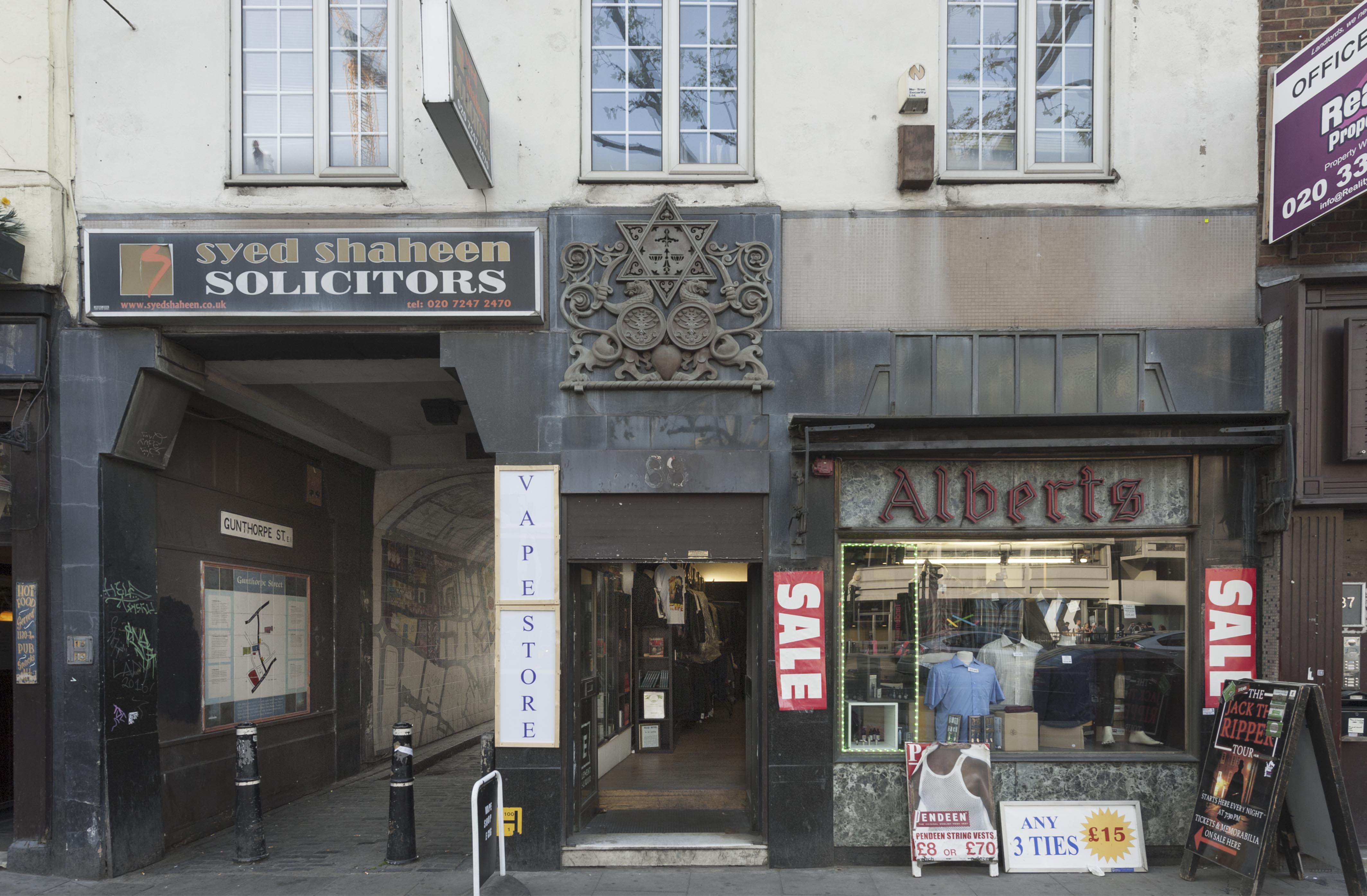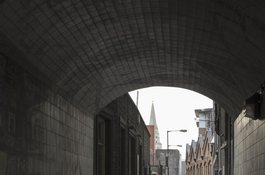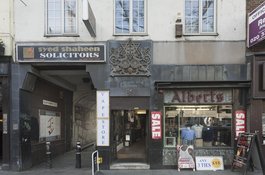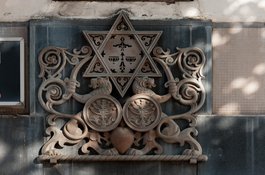88 Whitechapel High Street
early 19th-century shop and office building, with entryway to Gunthorpe Street and decorative features from occupancy by Jewish Post 1935
88 Whitechapel High Street
Contributed by Survey of London on July 11, 2018
This substantial four-storey building, three windows wide, appears to be as largely rebuilt and extended in 1838, apparently by James Goldie, distiller.1 Its predecessor was already a substantial building, with nine hearths, by 1666 when it was in the tenure of Hugh Best (perhaps the vintner and tenant of the Star Inn in Bishopsgate, who had leased Whitechapel property to John Sanford before 1677, see below) who had departed by 1674.2 By 1720 it was the London premises of Samuel Bellamy, coppersmith of Whitechapel and Erith, who that year became tenant and subcontractor to the English Copper Company, of two coppermills and a dwelling house on the Wandle at Wimbledon.3 Bellamy left all his property in Whitechapel and Wimbledon to his widow, Elizabeth, who in turn in 1732 bequeathed them to William Thoyts (1708-73), whose father, her husband’s executor, was her cousin.4 From then till his death in 1773, No 88 was run by Thoyts, described as ‘a great Coppersmith in Whitechapel’, and ‘the King of the Tinkers’, who married well and died in 1773 possessed of a substantial fortune. From 1753 the governess of Thoyts’s two young daughters was Jane Warton, who published proto-feminist literature anonymously.5 Thoyts’ business and property in 1773 passed to his son John, who outlived him by only two years, leaving the business, including copper mills William had taken at Merton in 1769 (having previously moved from Bellamy’s mills to some at Carshalton) to be run by his assistant Peter Robinson, until his son, William Thoyts, achieved his majority, and the firm, as Thoyts, Miners and Co. was at 88 Whitechapel High Street till 1807, succeeded by Morgan & Ward, and Thoyts, Morgan & Ward moved to 63 Whitechapel High Street in 1809, continuing there, as G. Thoyts & Tritton, with a warehouse in Wapping, until 1828.6 By 1812 No 88 was the Coffee Mart, John Johnson, agent for the West India Merchants.7
No. 88 appears to have been substantially rebuilt in 1838 after it was taken over from Dudderidge & Co., drapers, by a Scots distiller, James Goldie, who had in 1836 built a new distillery adjoining to the rear in George Yard (Gunthorpe Street).8 Goldie over-extended himself financially – it was said on his own house, Blake Hall in Wanstead – and was bankrupt by 1841.9 The premises were taken over by a newly formed, and inadequately financed gin distillers, the British Hollands Company, who employed Goldie as manager, a role he fulfilled concurrently as founding Secretary of the Commercial Gas Light and Coke Company from the same address.10 While the British Hollands was out of business by 1843, the gas company flourished, having secured an ‘eligible site’ on the Regent’s Canal in Mile End, and were soon supplying most of East London.11 The gas company moved offices by 1845 and Goldie left London, and from 1847 for nearly ninety years, No. 88 was an auctioneer and pawnbrokers, firstly George Bonham, ousted by the expansion of Venables drapers into his former premises at Nos 104-05.12 The large distillery room built in 1836 by Goldie to the rear of the premises in George Yard had become the George Yard Ragged School in 1855.
Ashridge Brothers, pawnbrokers, had been in situ for fifty years when No. 88 became offices in 1934-5 for the short-lived Jewish Daily Post, the ground floor reinforced by Holland, Hannen & Cubitts to take the presses. ‘Its primary object is to give an unbiassed account of daily happenings of interest in Jewish life’, However, the paper struggled to compete with its long- established rival Di Tsayt (‘The Jewish Times’) and went into liquidation in 1935 after being sued by a rabbi over a salacious story it printed about him.13 The new paper no doubt also came into conflict with the vested interests of the ‘closed shop’ English print unions, not to mention ruffling the feathers of assorted Nazis and fellow travellers.14
The most striking addition from the Post’s brief sojourn, are the decorative metal reliefs by Arthur Szyk (1894-1951), commissioned by the paper in 1935. Szyk was born into a prosperous Jewish family in Lodz, and had studied drawing and painting at the progressive Académie Julian in Paris. He had also developed a line in political caricatures, which earned him considerable fame after he emigrated to the United States in 1940, but his earliest anti-Hitler cartoons were published in February and March 1935 in the Jewish Daily Post.15 The same year the Post commissioned metal reliefs from Szyk, two of which survive over the main door of No. 88, and inside above the entrance to the lift. That on the entrance depicts a Magen (Star of) David supported by two Lions of Judah and wielding sabres. Beneath is a pair of medallions, decorated with Menorot or seven-branched candelabra. That above the lift entrance on the first floor (another was destroyed in a fire) depicts traditional Jewish symbolism often found on Torah Arks: two Lions of Judah holding the Luhot (the Tablets of the Law) inscribed with the first Hebrew letters of each of the Ten Commandments.16. The current business, Albert's menswear, has been in occupation since 1942, the front of the shop latterly augmented by an additional business offering Jack the Ripper tours and vaping accoutrements. The shopfront of polished granite with brass-framed windows, along with shop panelling, apparently dates from alterations in the 1950s.17 The entry arch to Gunthorpe Street through No. 88 has tiled decoration painted with a map of the area, inspired by Ogilby & Morgan's 1676 map of London, partly undertaken by pupils of Canon Barnett School under the artistic direction of Rachel Johnstone, as part of the Bethnal Green City Challenge regeneration programme, c. 1995.18
-
London Metropolitan Archives (LMA), Land Tax returns (LT) ↩
-
Hearth Tax returns (HT) 1666 and 1674-5: The National Archives (TNA), PROB 11/367/97: Kenneth Rogers, ‘On some issuers of 17th-century London tokens, whose names were not known to Boyne and Williamson’, The Numismatic Chronicle and Journal of the Royal Numismatic Society, Fifth ser./8, 1928, p. 64: Charles Matthew Clode, ed., Memorials of the Guild of Merchant Tailors of the Fraternity of St John the Baptist, London 1875, pp. 32-3 ↩
-
London Gazette, 2 to 5 Jan 1720: LMA, CLC/B/192/F/001/MS11936/012: E.N. Montague, Copper Milling on the Wandle, Merton Historical Society, 1999: http://www.wandle.org/mills/mitchammill.pdf: http://www.wandle.org/aboutus/mills/mcgow/mcgow37.htm: http://www.wandle.org/mills/wimbledonmill.pdf ↩
-
TNA, PROB 11/593/72; PROB 11/653/366 ↩
-
London Daily Post, 28 Nov 1735: Lloyd’s Evening Post, 24 to 26 Nov 1773: Gentleman’s Magazine, March 1799, p. 259: Stephen Hughes, Copperopolis: Landscapes of the Early Industrial Period in Swansea, Aberystwyth 2008, p. 44: _Oxford Dictionary of National Biography sub _Warton ↩
-
Post Office Directories (POD): E.N. Montague, The ‘Amery Mills’ of Merton Priory, the Copper Mills and the Board Mills, Merton Historical Society, 1997: http://www.wandle.org/mills/amerymill.pdf ↩
-
POD: LT: The New Complete Guide to All Persons who Have Any Trade Or Concern with the City of London or Parts Adjacent, London 1788, p. xx: Wakefield’s Merchant and Tradesman’s General Directory for London, London 1794, p. 307: TNA, PROB 11/1007/26: Bury and Norwich Post, 18 March 1812, p. 1 ↩
-
LT: Morning Advertiser, 2 July 1836, p. 1 ↩
-
Census: Morning Advertiser, 26 March 1840, p. 1 ↩
-
Morning Advertiser, 11 April 1838, p. 1 ↩
-
Anthony Francis, Stepney Gas Works: The Archaeology and History of the Commercial Gas Lighgt and Coke Company’s Works at Harford Street, London E1, 1837-1946, London 2010 ↩
-
Post Office Directories (POD) ↩
-
JC, 10 Sept 1999, New Year Pull Out pp. x-xi ↩
-
Daily Herald, 5 Feb 1935, p. 11: Londonderry Sentinel, 7 March 1935, p. 2: Sheffield Independent, 24 April 1935, p. 6: Gregor Schwartz- Bostunisch, Juedischer Imperialismus, Landsberg-am-Lech, 1935, p. 388: Leonard Prager, Yiddish Culture in Britain, Frankfurt, 1990, p.526 ↩
-
information Dr Jaap Harskamp ↩
-
National Heritage List, 1391964: Tower Hamlets Local History Library and Archives (THLHLA), L/THL/D/2/30/170: Szyk identification first made by Charles O’Brien for Pevsner City Guides: London East, New Haven & London, 2005, p.428: Joseph P. Ansell, Arthur Szyk: Artist, Jew, Pole, Oxford 2004, pp.88-9: Steven Luckert, The Art and Politics of Arthur Szyk, Washington, United States Holocaust Memorial Museum, 2003 ↩
-
POD: THLHLA, L/THL/D/2/30/170 ↩
-
http://www.exploringeastlondon.co.uk/eel/Whitechapel/Whitechapel.htm#R adicals ↩
Listed building description of 88 Whitechapel High Street
Contributed by Aileen Reid on Aug. 5, 2016
788/0/10224 WHITECHAPEL HIGH STREET 16-MAY-07 88
II Shop of 1950s, with two signs of 1934-5 by Arthur Szyk, in early C19 building.
The special interest of 88 Whitechapel High Street is limited to the two Arthur Szyk signs, one on the exterior and the other above the first floor lift shaft.
SIGNS: The external decorative sign is situated over the entrance of the shop and is a metal relief, painted gold and fixed to the wall.
 Shopfront of 88
Whitechapel High Street showing decorative sign by Arthur Szyk, 1934-5, and
entryway to Gunthorpe Street. Photographed by Derek Kendall, February 2016
Shopfront of 88
Whitechapel High Street showing decorative sign by Arthur Szyk, 1934-5, and
entryway to Gunthorpe Street. Photographed by Derek Kendall, February 2016
The design is a Magen David, or Star of David, supported by two lions of Judah rampant and wielding sabres. Beneath is a pair of medallions, decorated with Menorot or seven-branched candelabra. The clawed feet of the lions rest on a thin turned base which is fixed to the wall.
The most striking interior feature is a second sign, similar to that on the shop front, above the lift entrance on the first floor, depicting traditional Jewish symbolism often found on Torah Arks. The relief is painted in thick white paint. The design is two Lions of Judah holding the Luhot (the Tablets of the Law) inscribed with the first Hebrew letters of each of the Ten Commandments, topped by a Crown (the Keter Torah or Crown of the Law). At the base is a Magen David, with a heart at its centre. The clawed feet of the lions rest on a frieze of volutes and swirls. Originally, there were signs on each floor, and all but this one were destroyed in a fire in the second half of the C20.
EXTERIOR: 88 Whitechapel High Street is a typical stock brick building of the C19, stuccoed to the front, which is not of special architectural interest. It is of four storeys and three window bays, and the roof is concealed behind a parapet. The shop front, which is of some interest, is faced in polished granite and the door and the window surrounds are brass. There are two display windows, one to Whitechapel High Street, the second on the return to the alley. Each has a single, wide aperture between a fascia and stall riser, both of veined marble. Above the marble fascia is an eight-light aperture with brass surrounds in an Egyptian-inspired shape with battered sides. This mirrors the profile of the opening to the alley, creating the impression of symmetry. Viewing the elevation as a symmetrical composition draws out the prominence of the sign, situated in the centre of the two openings to the window and the alley. There is white mosaic above the granite facing.
INTERIOR: Inside, the shop retains a number of features from its C20 refurbishment which are of some interest. These include dark wood panelling, largely concealed behind the modern free standing shelves, a staircase leading to the basement with a plain square newel post and a prominent dentil cornice. The interior of the rest of the building, excepting the second sign, is not of special interest.
HISTORY: 88 Whitechapel High Street dates from the early C19, though the shop front, windows and sections of the interior have been refurbished on two occasions in the mid C20. The first was by H P Sanders in 1934-5 for the Jewish Daily Post, a short-lived successor to the Jewish Express, as recorded in the Drainage Files at Tower Hamlets Local Studies Library. This involved the refurbishment of the upper storey offices and the erection of several signs, depicting Jewish emblems, two of which survive (one externally and one internally). Having been established in 1926, the Jewish Daily Post ceased circulation in August 1935 shortly after the refurbishment. The second reconfiguration dates from the 1950s when the ground floor shop was refurbished for Alberts Menswear who moved there in 1942, after their premises nearby was damaged in an air raid. In recognition of the building's continuing Jewish connections (Alberts were part of the Jewish rag trade), this refurbishment incorporated the older sign into the design of the shop front. The shop front design is in the fashion of the 1930s, as seen in the Egyptian- inspired Art Deco lights and the use of red neon, which continued in many commercial premises after the war.
The signs at 88 Whitechapel High Street were designed by Arthur Szyk (1894-1951), a noted artist of Polish-Jewish origin. Szyk's authorship was ascertained by his biographer, Joseph Ansell, and further enquiries have revealed that Szyk's daughter remembers the artist working on the commission which she recalls was instigated by a Mr Solomon. Leaving London in 1940, Szyk became one of America's leading political artists by producing anti-Nazi cartoons during World War II. He was also a celebrated illustrator who created many works in the tradition of illuminated manuscripts. One such work was his Haggadah (the Passover story) published in London in 1940, after publishers in Poland and Czechoslovakia were reluctant to support the anti-Nazi work. For this reason, Szyk was in London sporadically from the early 1930s until 1940 when he toured Canada and the United States and eventually settled in the US after WWII. Szyk's work has recently been the subject of exhibitions at the Library of Congress and the United States Holocaust Memorial Museum, both in Washington DC. The signs are related to Szyk's other work, for example the design of the internal sign is also used in the title page for the Haggadah which Szyk created shortly after Germany annexed Austria in 1938, although it did not appear in the final version. This is, however, the only composition by him executed in sculptural form.
The area around Whitechapel was the home of the majority of Jewish émigrés in the C19 and early C20 following the Pogroms of the 1880s in Eastern Europe, and is an area of great significance to the history of the Jewish people in Britain nationally as well as locally. Near to 88 Whitechapel High Street, the synagogue at 19 Princelet Street, the Jewish soup kitchen on Brune Street and the Jewish memorial to Edward VII on Whitechapel High Street (all Grade II) are testimony to the distinctively Jewish character of the area in the late C19 and early C20.The 1930s were a particularly significant decade in the area as evidenced by the anti-fascist demonstrations at Cable Street in 1936, which initially took place at Aldgate just metres from 88 Whitechapel High Street.
SUMMARY OF IMPORTANCE: The two Szyk signs are of considerable special interest. Firstly, the elegant designs are unique and by an artist who is of considerable importance in the Jewish history of the C20. Szyk is not known to have designed any other relief panels and this is his only work in any medium in the UK. Secondly, the signs at 88 Whitechapel High Street are thought to be one example of a very small number of historic Jewish commercial signs in the country. The signs at 88 Whitechapel High Street use recognisable and distinctive Jewish emblems or language to announce the identity of the proprietors and are a prominent advertisement of ethnicity, suggestive of the proprietors' confidence that the design would be well-received in what was a distinctively Jewish area. This is of special historic interest in the context of the 1930s, when persecution of Jews increased in Europe and tensions in the East End of London resulted in clashes. The early C19 building at 88 Whitechapel High Street is by no means special in a national context, and the shop front, while interesting, is not remarkable.
SOURCES: Joseph Ansell, Arthur Szyk: Artist, Jew, Pole (2004), 88. Post Office Directories, 1933-1945. Information from Kathryn Morrison, Sharman Kadish and Charles O' Brien. N. Pevsner, B. Cherry and C. O'Brien, Buildings of England: London East (2005). K. Morrison, English Shops and Shopping (2003) 60-61, 207. S. Kadish, Jewish Heritage in England (2006), 16-17.
Selected Sources
Books and journals
Ansell, J, Arthur Szyk Artist Jew Pole, (2004), 88
Kadish, S, Jewish Heritage in England, an Architectural Guide, (2006), 16-17
Morrison, K, English Shops and Shopping An Architectural History, (2003), 207
Pevsner, N, Cherry, B, O'Brien, C, The Buildings of England: London 5 East , (2005)
National Grid Reference: TQ 33959 81431

Entrance to Gunthorpe Street under 88 Whitechapel High Street in 2016
Contributed by Derek Kendall

88 Whitechapel High Street in 2016
Contributed by Derek Kendall

Detail of Arthur Szyk signage, 1935
Contributed by Derek Kendall